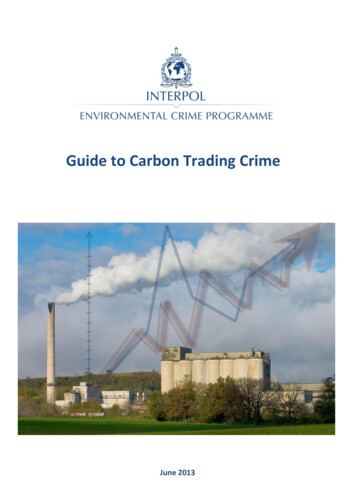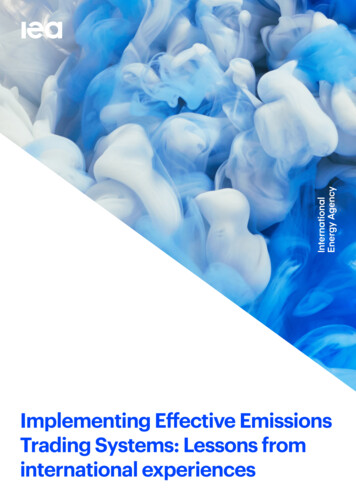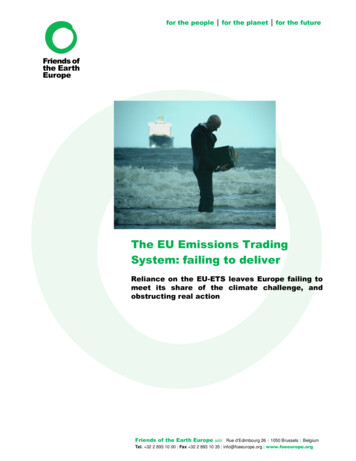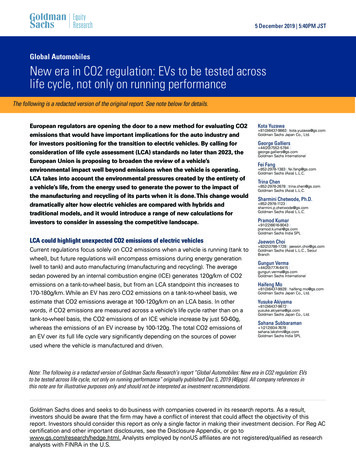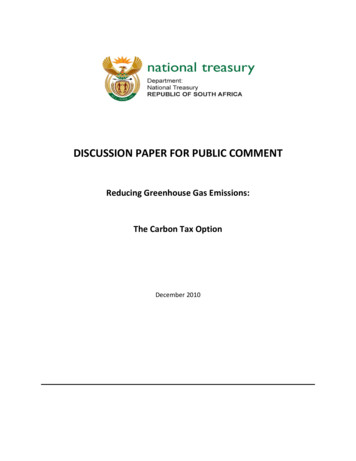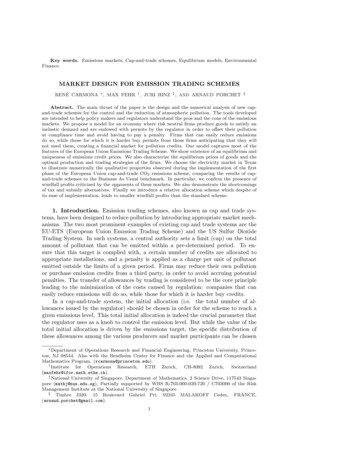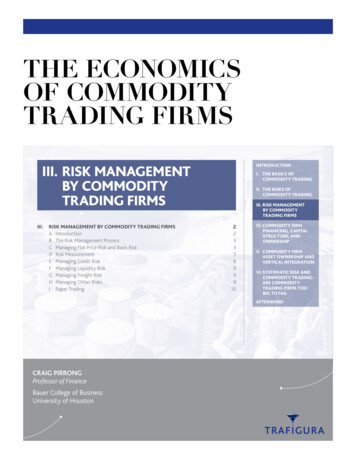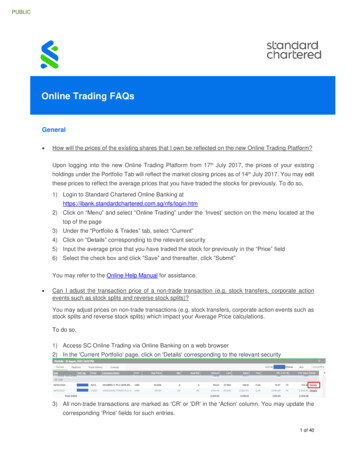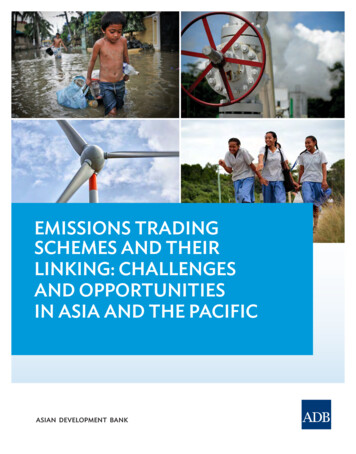
Transcription
EMISSIONS TRADINGSCHEMES AND THEIRLINKING: CHALLENGESAND OPPORTUNITIESIN ASIA AND THE PACIFICASIAN DEVELOPMENT BANK
EMISSIONS TRADINGSCHEMES AND THEIRLINKING: CHALLENGESAND OPPORTUNITIESIN ASIA AND THE PACIFICASIAN DEVELOPMENT BANK
Creative Commons Attribution 3.0 IGO license (CC BY 3.0 IGO) 2016 Asian Development Bank6 ADB Avenue, Mandaluyong City, 1550 Metro Manila, PhilippinesTel 63 2 632 4444; Fax 63 2 636 2444www.adb.org; openaccess.adb.orgSome rights reserved. Published in 2015.Printed in the Philippines.ISBN 978-92-9257-372-0 (Print), 978-92-9257-373-7 (e-ISBN)Publication Stock No. RPT167931-2Cataloging-In-Publication DataAsian Development Bank.Emissions trading schemes and their linking - challenges and opportunities in Asia and the PacificMandaluyong City, Philippines: Asian Development Bank, 2016.1. Emissions Trading2. Climate ChangeI. Asian Development Bank.The views expressed in this publication are those of the authors and do not necessarily reflect the views and policiesof the Asian Development Bank (ADB) or its Board of Governors or the governments they represent.ADB does not guarantee the accuracy of the data included in this publication and accepts no responsibility for anyconsequence of their use. The mention of specific companies or products of manufacturers does not imply that theyare endorsed or recommended by ADB in preference to others of a similar nature that are not mentioned.By making any designation of or reference to a particular territory or geographic area, or by using the term “country”in this document, ADB does not intend to make any judgments as to the legal or other status of any territory orarea.This work is available under the Creative Commons Attribution 3.0 IGO license (CC BY 3.0 o/. By using the content of this publication, you agreeto be bound by the terms of said license as well as the Terms of Use of the ADB Open Access Repositoryat openaccess.adb.org/termsofuseThis CC license does not apply to non-ADB copyright materials in this publication. If the material is attributedto another source, please contact the copyright owner or publisher of that source for permission to reproduce it.ADB cannot be held liable for any claims that arise as a result of your use of the material.Attribution—In acknowledging ADB as the source, please be sure to include all of the following information:Author. Year of publication. Title of the material. Asian Development Bank [and/or Publisher].https://openaccess.adb.org. Available under a CC BY 3.0 IGO license.Translations—Any translations you create should carry the following disclaimer:Originally published by the Asian Development Bank in English under the title [title] [Year of publication]Asian Development Bank. All rights reserved. The quality of this translation and its coherence with the original textis the sole responsibility of the [translator]. The English original of this work is the only official version.Adaptations—Any adaptations you create should carry the following disclaimer:This is an adaptation of an original Work Asian Development Bank [Year]. The views expressed here arethose of the authors and do not necessarily reflect the views and policies of ADB or its Board of Governors or thegovernments they represent. ADB does not endorse this work or guarantee the accuracy of the data included in thispublication and accepts no responsibility for any consequence of their use.Please contact OARsupport@adb.org or publications@adb.org if you have questions or comments with respectto content, or if you wish to obtain copyright permission for your intended use that does not fall within these terms,or for permission to use the ADB logo.Notes:(i) In this publication, “ ’ refers to US dollars.(ii) ADB recognizes “China” as the People’s Republic of China, “Korea” as the Republic of Korea, “Russia” as theRussian Federation, and “Vietnam” as Viet Nam.
iiiContentsTables and Figures vForeword viiPreface ixAcknowledgments xAbbreviations xi1Context: Carbon Pricing Instruments for Developing Member Countries Carbon Pricing Options Choosing the Right Carbon Pricing Approach Emissions Trading Systems in Asia and the Pacific 12462Existing Emissions Trading Systems—Theory and Practice Theory—Building Blocks of Emissions Trading Systems Practice—Existing Emissions Trading Systems Theory—Possible Linking Arrangements Linking Experiences 3Key Challenges and Lessons Learned from Existing Emissions Trading Systems 34Overview 34 Political Desirability and Legal Frameworks Play Decisive Role in EmissionsTrading Systems 35Flexibility to Address Oversupply 36Consequences of Offsets for Allowance Surpluses and Emissions TradingSystem Abatement 39Framework to Incentivize Long-Term Investment 41Allocation as a Fair System that Supports Long-Term Competitiveness 44 Banking May Have Longer-Term Implications for Future Emission Reductionand Carbon Price 46Institutional Setup and Operation 47Prefecture-Level Trading (Tokyo Cap-and-Trade Program) 48 Summary on Lessons for the Future Development of Emissions Trading Systems 484Emissions Trading Systems in Developing Member Countries People’s Republic of China Emissions Trading System Kazakhstan’s Emissions Trading System Emerging Initiatives: India, Indonesia, Thailand, Viet Nam 8816303249505253
ivEmissions Trading Schemes and their Linking - Challenges and Opportunities in Asia and the Pacific5 Key Challenges Faced by Developing Member Countries and a Blueprintfor the Future Political Commitment and Uncertainty Policy Interactions Target Setting and Flexibility Legal Framework and Enforcement Institutions and Monitoring, Reporting, and Verification Capacity Allocation Mechanisms The Functioning of the Market Enabling Conditions Summary—A Staged Approach 6 Linking: Key Challenges and What Can Be Learnedfrom International Experience Lessons Learned from International Experience of Linking Linking Enablers and Barriers in Developing Member Countries Strategic Approach toward Linking Emissions Trading Systems in Asiaand the Pacific Appendices1Track Record of Existing Emissions Trading Systems 2Advantages and Disadvantages of Linking Emissions Trading Systems 3Energy, Greenhouse Gas, and Renewable Energy Policy Instruments 5555565860636566676869707179869397References 100
vTables and FiguresTables1.1 Existing and Emerging Emissions Trading Systems 62.1 Emissions Trading Systems Examined in Section 6 172.2 Overview of the European Union Emissions Trading System 172.3 Overview of the Regional Greenhouse Gas Initiative 192.4 Overview of the Western Climate Initiative 212.5 Overview of the Alberta Greenhouse Gas Reduction Program 232.6 Overview of the New Zealand Emissions Trading System 242.7 Overview of the Australian Carbon Pricing Mechanism 252.8 Overview of Japanese Prefecture Level-Based Emissions Trading Systems 272.9 Overview of the Republic of Korea Emissions Trading System 282.10 Experiences of Linking Emissions Trading Systems 323.1 Experience and Lessons from Existing Emissions Trading Systems 353.2 Phase III Cap and Change of Emissions Outlook 464.1 Overview of Emissions Trading Systems in the People’s Republic of China 504.2 Overview of the Emissions Trading System in Kazakhstan 524.3 Overview of Emissions Trading Systems in India, Indonesia, Thailand, and Viet Nam 545.1 Average Annual Growth Rate in Gross Domestic Product and Carbon DioxideEmissions 585.2 Compliance to the Emissions Trading Systems in the People’s Republic of Chinafor the First 2 Years 615.3 Trading Volume of Emissions Trading Systems in the People’s Republic of Chinafor the First 2 Years 666.1 Trading Relationships between the Largest Economies in Asia and the Pacific 726.2 International Carbon Action Partnership Research on the Relative Importance ofEmissions Trading System Design Elements on Linking 746.3 Summary of Reduction Targets and Trading System Implementation by Country 75A1.1 Aggregated Compliance Outcome of the Alberta Greenhouse Gas Project,2007–2014 91A2.1 2011 Key Economic Indicators and Carbon Emissions Indicators in the Countrieswith Carbon Trading Potentials in Asia and the Pacific 94Figures1.1 Visual Guide of the Sections 1.2 Existing and Emerging Emissions Trading Systems in Asia and the Pacific 2.1 Visual Guide of the Sections 2.2 Key Elements of an Emissions Trading System 2.3 Direct Linking between Three Systems 2.4 Indirect Linking 17893032
viEmissions Trading Schemes and their Linking - Challenges and Opportunities in Asia and the Pacific3.1Visual Guide of the Sections 3.2 Evolution of European Union Allowance from 2005–2015 3.3 Regional Greenhouse Gas Initiative Power Plant Emissions Comparedwith their Caps 3.4 Oversupply of Allowances in the European Union Emissions Trading System 3.5 Freely Allocated European Union Allowance vs. Emissions in Industrial Sectors 4.1Visual Guide of the Sections 5.1Visual Guide of the Sections 6.1Visual Guide of the Sections 6.2 Approach to Harmonization and Linking of Systems 6.3 Steps to Approach Linking A1.1 Evolution of Gross Domestic Product (in Real Terms), Greenhouse GasEmissions, and Emissions Intensity A1.2 Greenhouse Gas Emissions by Main Sector in EU-28, Change 1990–2012and 2012 Shares A1.3 Aggregate Change in Total CO2 Emissions from Fossil Fuel Combustionin the EU-28, during Phase I and Phase II of the European Union EmissionsTrading System A1.4 Regional Greenhouse Gas Initiative: Emissions and Economic Growth A1.5 Distribution of Auction Revenues A1.6 Changes in Emissions 34373739454955698081868788899092
viiForewordA successful policy response to the challenges posed byclimate change will be critical to the future developmentof Asia and the Pacific. With high rates of economicgrowth, the region must pursue low carbon developmentpath and make its contribution in cutting greenhousegas (GHG) emissions to keep global warming well below2 C compared to pre-industrial levels. The recentlyconcluded Paris Agreement on climate change includes acommitment by the global community to drive efforts tolimit the temperature increase even lower to 1.5 C abovepre-industrial levels.Without such action, Asia and the Pacific will account for more than 40% of globalGHG emissions in the next decade. The region, home to 60% of the world population,is especially vulnerable to the effects of climate change. Rising sea levels and extremeweather events of higher frequency and increased intensity pose vital threats to thehealth and safety of over 4 billion people in the region and particularly put the poor atrisk. However, low carbon growth in the region offers opportunities not only for metingout challenges posed by the climate change but also for enhanced economic activitiesfacilitating more efficient industries to compete more successfully on global markets.Action on climate change is central to the Asian Development Bank’s (ADB’s) vision of anAsia and the Pacific free of poverty and its mission to help developing member countries(DMCs) improve the living conditions and quality of life of their people. Robust policiescreating the requirement and flexibility to reduce GHGs in a cost-effective manner, aswell as supporting the mobilization of finance for the development and deploymentof innovative technologies, will be essential to underpin climate change efforts in theregion. Emissions trading systems (ETSs) can be important tools for achieving these aimseffectively and efficiently. Since the European Union (EU) ETS was founded in 2005,the number and coverage of ETSs have been accelerating. As of 2015 there were 17 ETSsin place across four continents, ranging in scale from city, province, national, and supernational levels, which together cover 40% of global gross domestic product (GDP). In Asiaand the Pacific there are 11 ETSs operating, with more being planned.As we look to more concerted and ambitious actions to cut GHG emissions, the linking ofETSs will be an important approach. It encourages emissions savings where they are costeffective, and minimizes the impact of carbon costs on competing industries through a
viiiEmissions Trading Schemes and their Linking - Challenges and Opportunities in Asia and the Pacificcommon carbon pricing mechanism. The Paris Agreement established a mechanism forvoluntary cooperative approaches for GHG mitigation between countries, which may intime become the basis for international collaboration on emissions trading.The growing wealth of experience with ETSs can be valuable to support DMCs that areplanning and designing new systems of their own. In view of this, it is an endeavour tosummarize some of the most significant learning experiences to date and describes thesolutions to the challenges that have been faced. It also provides experiences to helppolicymakers, drawing on linkages planned or implemented in the United States and EU.While linking may be a longer-term issue for DMCs that are early in their carbon marketdevelopment journey, the experiences elsewhere with linked systems show the importanceof early design choices that can later underpin links between trading systems.This knowledge product has been developed under the regional capacity developmenttechnical assistance project Supporting the Use of Carbon Financing to Promote GreenGrowth in Asia and the Pacific.Ma. Carmela D. LocsinDirector GeneralSustainable Development and Climate Change DepartmentAsian Development Bank
ixPrefaceThis knowledge product on the current and emerging emissions trading systems (ETSs),interlinking of ETSs, and outlook for future carbon markets in Asia and the Pacific has beenprepared to support policymakers and practitioners in the development of their ETSs.Section 1 presents different policy instruments available to reduce greenhouse gas (GHG)emissions and incentivize investment in low-carbon abatement within jurisdictions.The section also lays a particular emphasis on the policy design considerations from theperspective of developing member countries (DMCs).Section 2 provides an overview of the design of existing ETSs which entails the theoreticalbuilding blocks for designing an ETS—with particular emphasis on the modalities andharmonizing requirements to enable linking of ETSs. The section also covers institutionalinfrastructures, legal foundations, supporting policies, and the basic design of a tradingframework. The design issues examined include coverage definition; cap setting; allowanceallocation mechanisms; monitoring, reporting, and verification frameworks; and flexiblemechanisms. Subsequently, the ways in which these building blocks have been applied inpractice in existing ETSs is explored, by presenting an overview of the key design elementsof eight existing ETSs.The descriptions on the building blocks are followed by analyses of the experience of thesejurisdictions in implementing and operating these ETSs, reviewing the challenges faced andthe lessons learned (Section 3). Particular attention is given to the causes of over allocationin some existing systems, especially in Canada, the US, and the EU, and the measures thathave been employed to address these. Detailed examination is given to rules concerninguse of offsets for compliance and the effect they have had on abatement within tradingsystems and on allowance surpluses. Approaches to allocation that mitigate industrialcompetitiveness while avoiding windfall gains are also highlighted.Under section 4 an overview of the ETS and related initiatives being developed inDMCs has been provided. This section summarizes the key challenges being faced inthese jurisdictions, focusing especially on capacity building, institutional readiness, andcoordination issues associated with implementing new trading systems. Section 5 presentsa blueprint for developing an ETS based on the lessons learned in existing ETSs. Finally, anoverview of the theory and international experience in linking ETSs together with lessonslearned from this experience are presented under Section 6.
xAcknowledgmentsThis knowledge product has been produced by the Technical Support Facility, a componentof ADB’s Carbon Market Program under its Sustainable Development and Climate ChangeDepartment (SDCC) in implementation of the regional capacity development technicalassistance project R-CDTA 8223: Supporting the Use of Carbon Financing to PromoteGreen Growth in Asia and the Pacific.Ma. Carmela D. Locsin, director general, SDCC encouraged the development of thispublication. Xuedu Lu, advisor, and Preety Bhandari, director, Climate Change and DisasterRisk Management Division (SDCD), spearheaded the development of this knowledgeproduct. Jiwan Acharya, senior energy specialist, Energy Division, South Asia Departmentand Virender K. Duggal, senior climate change specialist (SDCD, SDCC) supported thedevelopment and finalization of this knowledge product.The research work in preparation of this knowledge product has benefited from inputs andsuggestions from the Climate Change Department, National Development and ReformCommission of the People’s Republic of China (PRC) and Teng Fei of Tsinghua University,PRC.This knowledge product has been prepared with immensely valuable inputs andcontributions from: Lingshui Mo, carbon market specialist (consultant); ChristianEllermann, climate finance specialist (consultant), Takeshi Miyata, transaction manager– Future Carbon Fund (consultant), Hanh Le, carbon market expert (consultant) andMadeline Rawlins, principal consultant, Mott MacDonald, UK. It would not have beenpossible to present this work in its current form without insightful review and excellentcontribution from Mark Johnson of Ricardo Energy & Environment - all of which aresincerely commended.
xiAbbreviationsADBAsian Development BankBAUbusiness as usualCDMclean development mechanismCH4methaneCO2carbon dioxidePRCPeople’s Republic of ChinaCPcompliance periodDMCdeveloping member countryEETSenergy efficiency certificate trading systemsETSemissions trading systemEUEuropean UnionGDPgross domestic productGHGgreenhouse gasHFChydrofluorocarbonMRVmonitoring, reporting, and verificationN2Onitrous oxideNAPNational Allocation PlanNH3nitrogen trifluoridePFCperfluorocarbonRGGIRegional Greenhouse Gas InitiativeSF6sulfur hexafluorideSMEssmall and medium-sized enterprisestCO2eton of carbon dioxide equivalentUNFCCCUnited Nations Framework Convention on Climate ChangeWCIWestern Climate Initiative
11 ontext: Carbon PricingCInstruments for DevelopingMember CountriesFigure 1.1: Visual Guide of the SectionsSection 1: Context: Carbon Pricing Instruments for Developing Member CountriesSection 2: Existing Emissions Trading Systems—Theory and PracticeSection 3: Key Challenges and Lessons Learnedfrom Existing Emissions Trading SystemsSection 4: Emissions Trading Systems in Developing Member CountriesSection 5: Key Challenges Faced by Developing Member Countriesand a Blueprint for the FutureSection 6: Linking: Key Challenges and What Can Be Learnedfrom International ExperienceThe 21st Conference of Parties (COP) under the United Nations Framework Convention onClimate Change (UNFCCC) in Paris December 2015 required for the first time that all partiesprepare an intended nationally determined contribution to the global climate agreement.The majority of Asian Development Bank’s (ADB’s) member countries (developingand developed) prepared an intended nationally determined contribution, with varyinggreenhouse gas (GHG) emissions reductions targets, mitigation and adaptation priorities; andthe policies and support required for achieving these.At a national level, member countries are increasingly developing carbon pricinginstruments, such as emissions trading, crediting, and carbon taxes, as part of a suiteof policies designed to support their achievement of such goals. In addition, according
2Emissions Trading Schemes and their Linking - Challenges and Opportunities in Asia and the Pacificto analysis by the World Resources Institute, many member countries have expressedopenness to the possibility of using market mechanisms to achieve their climate goals.1In line with ADB’s aims to support its developing member countries (DMCs) in theirdevelopment of carbon pricing instruments, this section introduces the basic conceptsand tradeoffs of three key approaches—emissions trading system (ETS), carbon taxes, andcrediting mechanisms— and explores how these can be used complementarily, before theremainder of the knowledge product provides an in-depth guide to developing and linkingETSs, with particular emphasis on issues faced by the DMCs.Carbon Pricing OptionsThe two main routes for carbon pricing are emissions trading and carbon taxes. The choiceof approach will be important for policymakers looking to create a carbon price signalto drive emissions abatement within a sector or multiple sectors of the economy(e.g., industrial, commercial, residential, agriculture, transport). Emissions trading optionsand carbon taxes can each be cost-effective and efficient ways to realize emissionsreductions.Emissions trading involves tradeable units that are used to represent emissions or emissionssavings. It can take the form of a cap-and-trade ETS (referred to here as an ETS) or acrediting mechanism. In an ETS, emissions are capped at a predetermined level and themarket establishes an emission price necessary to meet that cap. In crediting mechanisms,emission reductions relative to a baseline or target are credited, which can be for specificprojects, sector performance, or the result of policies. The price of credits is determined bydemand/supply balance. Actors may purchase credits either for compliance (targets withinthe system) or voluntary purposes.For carbon taxes the key difference is that the price of emissions is set by policy makersrather than by a market mechanism. The price level determines the level of economicallyviable abatement and the emissions result that is achieved.The choice and design of instruments for any specific jurisdiction will depend on itseconomic, social, and environmental objectives, circumstances, and the capacities of theparties that would be involved in developing and implementing the system.These main options are described briefly below. Emissions trading design choices aredescribed in more detail in Section 3, and the complementarity and compatibility withenergy efficiency and renewable energy trading systems are considered in Appendix 2.Emissions trading systemsIn an ETS, the main policy lever available to regulators is to control the volume of emissionallowances. This is formulated as a cap and translated into emission allowances that arereleased to the market either for free or at a charge. Mandated participants are required to1Bangladesh, Bhutan, Brunei Darussalam, Fiji, Indonesia, Japan, Kazakhstan, Kiribati, the Republic of Korea,Myanmar, New Zealand, Solomon Islands, Thailand.
Context: Carbon Pricing Instruments for Developing Member Countriesacquire emission allowances equal to their determined emissions over a compliance periodand surrender these back to the system administrator.The optimum compliance strategy for participants is to carry out abatement where itis cheaper than the carbon price but buy allowances where abatement would be moreexpensive. Thus, the price of allowances is dynamic, being determined in the market as thelevel of incentive necessary to meet the cap. The cost of meeting the target can be furtherreduced if credits from outside the system are permitted as a means of compliance,in cases where these credits are cheaper than the cost of abatement within the system. In asimilar way, linking between ETSs can minimize their collective costs of abatement.Since the carbon price can vary, the costs to participants are uncertain. To mitigate theimpacts, flexibility can be introduced, for example banking and borrowing rules at theparticipant level and flexibility mechanisms at the system level. Flexibility mechanisms mayinclude the withholding or release of allowances based on the prevailing level of scarcityor price.Carbon taxesA carbon tax allows regulators control over the price of carbon emissions, however theyhave less direct control over the environmental outcome—i.e., the emissions reductionsthat are actually achieved. It creates a fiscal liability for the emission of GHG, and taxedentities may either incur the liability or reduce it by investing in abatement measures. In thesame way as for emissions trading, regulated entities are incentivized to abate emissionswhere it is cheaper than the carbon price, but not where it is more expensive to do so.A carbon tax creates a stable price signal for investment in emissions abatement, in so far asthe tax rate is known and can be relied upon not to change.Crediting mechanismsCrediting mechanisms, whereby credits represent reductions in emission relative totargets or baselines, can be an important mechanism for enabling financial and technologytransfer and can be an effective tool for stimulating the growth of the low-carbon economy.Crediting may occur at the project or the programme level or involve the development ofsectoral or policy-based approaches.Crediting mechanisms can be used to complement both ETSs and carbon taxes. Use ofcredits can provide participants with the flexibility to meet their compliance obligations—whether the surrender of emissions allowances or the meeting of a tax liability. Importantly,credited emission reductions should be additional to those within the policy that is usingthe credits. Therefore crediting systems should only be created in sectors or regions notcovered by the ETS or carbon tax in question. Offsets counted towards the compliance ofthe buyer within an ETS or carbon tax regime cannot be claimed as reductions in the areawhere they were generated (double-counting).Although crediting mechanisms can be developed to complement either an ETS or carbontax, policymakers may wish to develop a crediting mechanism on a standalone basis to3
4Emissions Trading Schemes and their Linking - Challenges and Opportunities in Asia and the Pacificattract climate finance, whether at a local, national, or international level. Examples of suchclimate financing include results-based financing instruments, which provide an alternativesource of demand for such credits.2 An increasing number of dedicated funds are emergingwith the objective of purchasing robust emission reduction credits (usually with qualitativeor quantitative restrictions). Examples include ADB’s Future Carbon Fund (FCF), the WorldBank’s Transformative Carbon Asset Facility, the Pilot Auction Facility, the Forest CarbonPartnership Facility’s Carbon Fund, as well as providers of voluntary carbon offsets.Choosing the Right Carbon Pricing ApproachFurther to the inherent design features of carbon pricing options described above, there areadditional factors to be taken into account when choosing an approach. Each design optionhas its relative advantages and suitability to local policy circumstances, and these should becarefully considered when deciding the best way forward.ReadinessThe instruments differ significantly in terms of their readiness requirements, for both thepublic and private sector.Stakeholder readiness. While the public and private sector are generally familiar with theimplementation and compliance requirements of taxes, the same cannot be said for therole they may be expected to play as regulators, participants, and traders within an ETS.They may require significant capacity building support, and approaches such as pilots orvoluntary systems may be necessary.Institutional infrastructure. A carbon tax may utilize existing tax infrastructureand institutions, for instance through the extension to or revision of energy taxationarrangements. However, ETSs are more complex, requiring the creation and allocationof a new commodity, the establishment of market infrastructure including auctioningmechanisms, and the creation of new regulatory and enforcement arrangements.Both options require strong modeling capacity and good data availability, to set appropriatetax levels or emissions caps.Monitoring and reporting. ETSs and carbon taxes require the establishment of robustsystems for the monitoring and reporting of emissions, and use of emission reductionscredits, in order to ensure compliance.Verification. Both instruments create the requirement for high-quality confirmation ofdetermined emissions, such as third-party verification. This may require access to a pool ofsuitably qualified and experienced independent and accredited verifiers.2A program where payments are made upon achievement of certain results (i.e., GHG reduction). CleanDevelopment Mechanism is an example of results-based financing.
Context: Carbon Pricing Instruments for Developing Member CountriesStructure and Characteristics of Priority Mitigation SectorsThe characteristics of the sector or sectors being targeted will be important in informingpolicy choices.Participant number. Large numbers of participants help establish a liquid market forallowances.Participant size. Larger participant sizes can avoid the costs of monitoring, reporting, andverification (MRV) being disproportionate relative to the emissions of the installation orenterprise covered. Most ETSs have a minimum threshold for size of installations covered.For sectors with multiple small participants such as small and medium-sized enterprises(SMEs), carbon taxes may be preferable.Alignment with Development PrioritiesThe choice and design of a mechanism will depend on a country’s economic developmentpriorities. Crediting mechanisms can provide a source of financing for emission reductions,where there is a strong demand for the credits that are produced. It can help foster anew low-carbon growth industry focused on certain sectors or technologies and supporteconomic gr
4.2erview of the Emissions Trading System in Kazakhstan Ov 52 4.3erview of Emissions Trading Systems in India, Indonesia, Thailand, and Viet Nam Ov 54 5.1verage Annual Growth Rate in Gross Domestic Product and Carbon Dioxide A . Emissions 58 5.2 Compliance to the Emissions Trading Systems in the People's Republic of China
